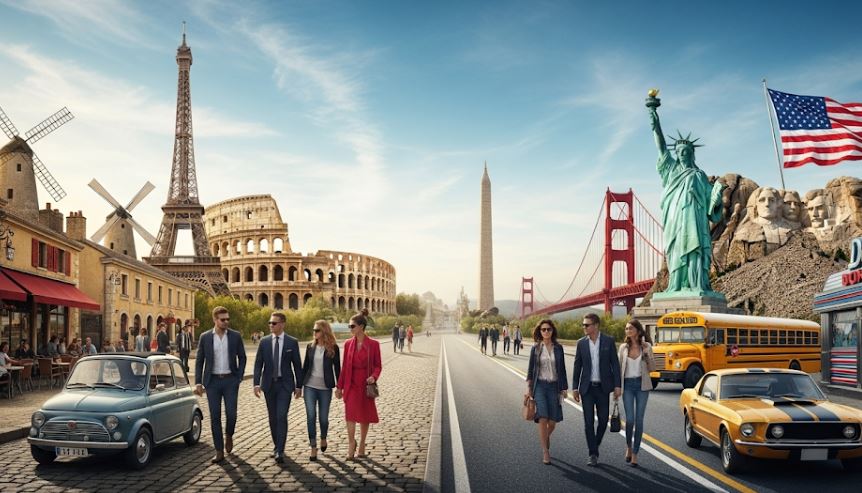
The age-old question, „How are Europeans different from Americans?”, sparks a fascinating journey into the heart of two distinct continents, revealing a rich tapestry of cultures, values, and daily routines. While both share a foundational Western heritage, centuries of unique historical trajectories, geographical influences, and societal developments have sculpted profoundly different approaches to life. It’s not about superiority or inferiority, but rather a vibrant exploration of diverse perspectives that continue to shape the global landscape.
One of the most immediate and striking differences lies in the concept of history itself. Europe, with its ancient cities, crumbling castles, and cobblestone streets, exudes a palpable sense of the past. History isn’t just taught in schools; it’s woven into the very fabric of daily life. Europeans often live amidst remnants of empires, revolutions, and artistic movements that predate America’s very inception. This deep historical rootedness fosters a certain reverence for tradition and a longer-term perspective on social and political issues. Americans, in contrast, hail from a relatively young nation, one that forged its identity through revolution and constant innovation. Their history is one of continuous progress and reinvention, leading to a more forward-looking, often individualistic, and less tradition-bound mindset.
This difference in historical context profoundly influences the pace of life. European cities, particularly in Southern Europe, often embrace a more relaxed, leisurely rhythm. Extended lunch breaks, evening strolls (the passeggiata), and a strong emphasis on work-life balance are common. Sundays are frequently reserved for family and rest, with many shops closed. The focus isn’t solely on productivity; quality of life and social connections hold significant weight. Americans, on the other hand, are often characterized by their fast-paced, results-driven approach. The work ethic is paramount, and efficiency is highly valued. Longer working hours, shorter vacations, and a constant pursuit of personal and professional advancement are more typical. The phrase „time is money” often encapsulates this distinct drive.
Social structures and public services also present a stark contrast. Many European nations boast robust social welfare systems, offering universal healthcare, comprehensive unemployment benefits, and generous parental leave. This often results in a strong sense of collective responsibility and a lower reliance on private charity. While taxes might be higher, citizens often feel a greater sense of security and support from the state. In America, the emphasis is more on individual liberty and self-reliance. While a social safety net exists, it is generally less extensive than its European counterparts, and private enterprise often plays a larger role in healthcare and other services. This fosters a culture where individual initiative and personal responsibility are highly celebrated, sometimes at the expense of communal support.
When it comes to daily interactions and social norms, subtle yet significant differences emerge. Europeans, especially in public settings, can sometimes appear more reserved or formal to American eyes. Politeness often manifests through quiet acknowledgment and a certain distance, particularly with strangers. Personal space tends to be smaller, particularly in crowded urban environments. Americans, by contrast, are generally known for their outgoing and friendly demeanor. They are often quicker to strike up conversations with strangers, and their communication style can be more direct and enthusiastic. While this can be perceived as refreshing by Europeans, it can also sometimes be seen as overly familiar or informal.
The role of food and dining also highlights cultural variances. In Europe, especially in countries like France or Italy, food is an art form, a communal experience, and a cornerstone of social life. Meals are often long, multi-course affairs, savored with good company and conversation. Locally sourced ingredients and traditional recipes are highly valued. The focus is on the experience of eating. Americans, while certainly appreciating good food, often view it with more emphasis on convenience and variety. Fast food culture is prevalent, and meals can be quicker and more utilitarian, often consumed on the go. Portions also tend to be significantly larger in America.
Furthermore, the perception of education and intellectual pursuits can differ. European education systems often emphasize a broad, liberal arts foundation and deep specialization. There’s a strong cultural appreciation for intellectual discourse, classical arts, and philosophical debate. University education is often heavily subsidized or free, making higher learning accessible to a wider demographic. In America, while strong liberal arts programs exist, there’s often a greater emphasis on vocational training and practical skills, especially at the university level. The cost of higher education can also be a significant barrier, leading to a more utilitarian approach to academic choices, with a focus on career prospects.
Even seemingly trivial aspects like fashion and personal presentation can reveal cultural nuances. Europeans often gravitate towards a more understated, classic, and sophisticated style, valuing quality over quantity. Dressing well is often seen as a sign of respect for oneself and others. Americans tend to embrace a more casual, comfortable, and diverse range of styles, reflecting a greater emphasis on individual expression and practicality. Brand recognition can also play a larger role in American fashion choices.
In conclusion, the differences between Europeans and Americans are not simply superficial but run deep into the very core of their societal values and individual outlooks. From their relationship with history to their approach to work, social welfare, and personal interactions, each continent offers a unique lens through which to view the world. Understanding these distinctions fosters greater empathy and appreciation for the diverse ways humanity organizes itself and strives for a fulfilling life. Ultimately, while separated by an ocean, both cultures contribute immensely to the rich tapestry of global human experience, offering valuable lessons and perspectives to one another.













